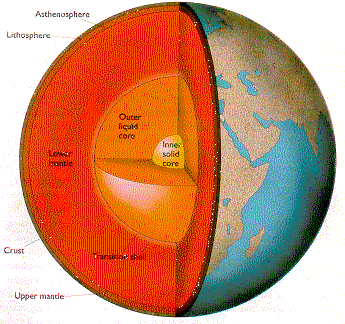

 |
 |
|
Due to gravity and radioactivity, which helped material be separated, the Earth is divided into three layers: the crust, its thin and cold skin, the mantle, the bulk of the planet, and the core , its heavy iron heart. The cause of this selective structure is that after its formation, the Earth's temperature continued to increase due to the decay of radioactive elements, which were then more abundant. Eventually the temperature reached a point where the metallic parts melted and the heavy molten metals sank to the earth's center. The earth had begun to separate into the above mentioned layers. We must remark, however, than appart from these main three layers, seismologists also distinguish between lithosphere, including the crust and the upper part of the mantle (about 200 km thick, and in a solid state), and the asthenoshphere (going down to 700 km, and in a viscous state). |

A modern cross section of the Earth gross structure, as revealed by studies of earthquakes |
The Crust is the uppermost layer of the solid Earth. Above it we find the athmosphere, and below it the mantle. There are two different types of crust on the Earth's surface: the continental and the oceanic crust, which differ in age, composition and thickness.
In the primordial Earth the crust was continously recycled by the vigorous convections movements in its interior and broken up by meteorite bombardment. But eventually when activity slowed down a little and the Earth began to cool, a new type of crust began to separate out from the original crust. Just as the very lightest material in boiling jam separates out and floats as scum on the surface, the earth, in a process which continues today, slowly created its own scum, continental crust, made largely of light and sticky granitic material. On average, continental crust is about 30-40 km thick and, following the same principle as floating icebergs, it is thickest under high young mountain ranges, like the Himalayas. Today, we walk on the parts of these floating rafts of scum which rise above sea level.
Beyond the edges of the continental shelves lies the thinner (5-6 km thick), but heavier, oceanic crust which underlines the deep-sea floors. The oceanic crust, made largely of dense basaltic rock, is similar to the crust of the other rocky planets in the solar system. The oceanic crust is still slightly buoyant but after a long period of time at the surface, it and the mantel directly below it, cool and evenutally become heavy enough to sink back down into the Earth, allowing new hot material to rise up and replace it. So compared to the young, self-renewing ocean floors, the rocks of the continents can be extremely old.
The mantle is the portion of the Earth's interior lying beneath the crust and above the core. No direct observation of the mantle, of its upper boundary, have been made; its boundaries have been determined solely by abrupt changes in the velocities and character of seismic waves passing through the earth's interior. Samples of the upper mantle may be provided by some volcanic eruptions in ocean areas, e.g., the Hawaian Islands Its upper surface is considered to be the Mohorovicic discontinuity, or Moho (depth about 30-40 km). Analysis of seismic waves indicates that rocks below the Moho are less rigid and slighly more dense than rocks making up the crust. A zone of low seismic velocity and rigidity just below the lithosphere, called the asthenosphere, is present in the upper part of tha mantle. It is characterized to be in a plastic state.The mantle lower limit is constituted by the Gutenberg discontinuity, at a depth of 2900 km below the surface.
Then entire mantle constitutes about 84% of the Earth by volume. Its materials, minerals rich in iron, magnesium, silicon and oxygen are in a soft and plastic state, though the pressure is too high for melting to take place. However, it is not brittle but can flow slowly, acting like a thick and viscous liquid, transporting heat by convection from the lower layers to the upper ones. This process is extremely slow and as yet not directly measurable.
The core lies below the mantle. The abrupt disappearance of direct S earthquake waves, which cannot travel through liquids, at depths below 2900 km indicates that the outer 2200 km of the core (also called outer core)are molten. It is thought, however, that the inner 1200 km (inner core) are solid.
According to astronomical data and experiments made in a laboratory, the core is probably made of the same material that formed and diferenciated the Earth at the beginning. This material is very dense, so the core has the highest amount of mass of the planet. Having a look to the abundances of elements in the cosmos, scientists have concluded that the main element which constituted it may be iron.
The outer core is thought to be the source of the Earth's magnetic field: In the dynamo theory, tidal energy or heat is converted to mechanical energy in the form of currents in the liquid core; this mechanical energy is then converted to electomagnetic energy, which we see as the magnetic field.